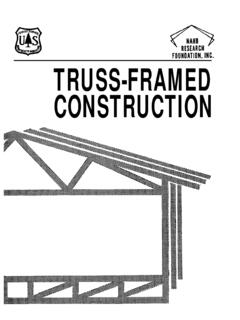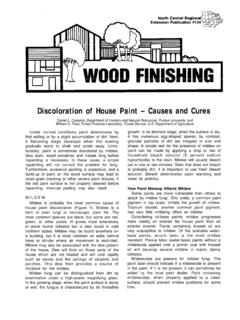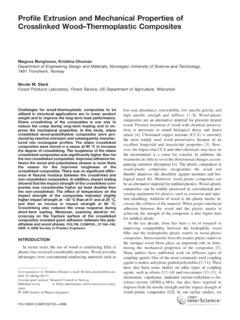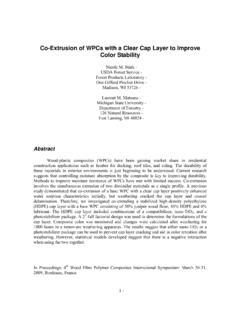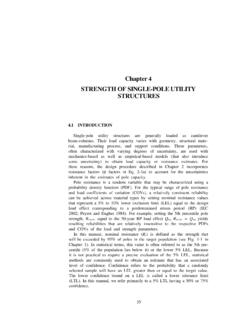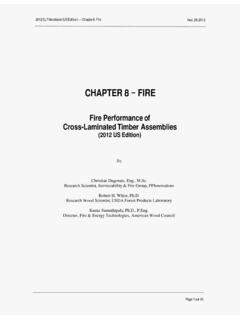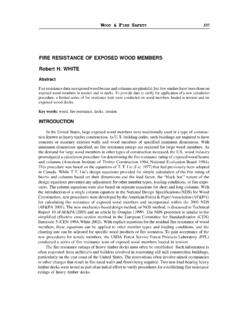Transcription of Construction Guide - Forest Products Laboratory
1 The Wood Tornado Shelter - Construction Guide November 2018 Page 1 The Wood Tornado Shelter Prepared by Home Innovation Research Labs for the Forest Products Laboratory Table of Contents Introduction Design Information Siting Lumber Requirements Safety Sequence of Construction Materials and Tools Section 1: Cutting the Lumber Section 2: Constructing the Beams Section 3: Building the Walls Section 4: Constructing the Ceiling Section 5: Attaching the Sheathing Section 6: Building and Hanging the Door Section 7: Providing Ventilation Section 8: Anchoring the Shelter Note to Reader Before ordering materials or starting Construction : Read all instructions as Construction options can affect quantity and size of materials needed.
2 Many steps are not reversible, so having a complete understanding of the Construction process prior to starting will minimize costly mistakes. Obtain approval of the plans and Construction Guide from your local building official to assure that this design is suitable for your jurisdiction. Introduction This 8 foot by 8 foot tornado shelter was developed by engineers at the US Department of Agriculture s Forest Products Laboratory to provide a design that is adaptable for existing Construction and that is easily constructed. Design Information The tornado shelter presented here was Laboratory tested to meet impact and wind pressure requirements.
3 The following information may be required with Construction documents. Type of shelter: Residential tornado The design meets the impact and wind pressure requirements of ICC 500-2014: Standards for the Design and Construction of Storm Shelters. Design Wind Speed: 250 mph Wind Exposure Category: C Internal pressure coefficient, GCpi: + Topographic factor, Kzt: Directionality factor, Kd: A statement must be provided that the floor of the shelter has been constructed above the highest recorded flood elevation if a flood hazard study has been conducted for the area or the minimum elevation required by authority having jurisdiction.
4 Extensive Laboratory testing was performed to assure that this 8 x8 tornado shelter meets the impact and wind pressure requirements of Chapters 3 and 8 of ICC The Wood Tornado Shelter - Construction Guide November 2018 Page 2 500-2014: Standards for the Design and Construction of Storm Shelters. Design assumptions and test results can be found in the following two documents: Other shelter sizes have not been tested. Wind speed/wind pressure calculations can be found in the following document: The door shown in this Construction Guide was Laboratory tested for debris impact for a 3 -0 width.
5 Location of the tornado shelter within a host building and a drawing of the entire building. A shelter section or elevation indicating the height of the shelter relative to the finished grade, finished floor and the host building, where applicable. Hold down design capacity: 4000 lb Assumed friction coefficient for concrete cast on soil, f: Occupant Load: 9 people Usable floor area: 49 sf Venting area: in2 Concrete foundation minimum requirements: a. 4 thick concrete slab b. 4000 psi minimum strength c. 6x6 welded wire reinforcement over the entire area OR No.
6 4 bars, at a maximum spacing of 18 in. on center in two perpendicular directions. d. Minimum 5 slab extension on each side of shelter to prevent foundation sliding and overturning. Design Limitations This shelter design meets the missile impact and wind load requirements of national standards for tornado shelters. As part of your planning process it is important to contact your local building department to determine if there are other requirements for tornado shelters in your area. For example, some jurisdictions have requirements on door swing direction, which may affect the suitability of this design to your location.
7 Because the door design presented here is self-built, it may not meet the door labeling requirements (Section ) of the ICC-500 standard. However, extensive Laboratory testing confirms that the door meets the impact and wind pressure requirements of the standard: Siting Before beginning Construction of the shelter, ensure that the installation site meets the following requirements: Proximity. If not located in the home, the shelter must be located a maximum distance of 150 ft. from the home. Protection from Rain and Snow. This shelter is not designed to be water-resistant and must be built inside the home, in a garage, or other structure that protects the shelter from the elements.
8 Concrete Foundation. If the foundation does not meet the requirements stated earlier, FEMA P-320 provides foundation Construction details: Detachment from Host Building. Do not attach any portion of the shelter to an adjoining wall or to the floor or roof framing of the enclosing structure (or vice versa). Costs The designers of this tornado shelter estimate a material cost of between $3500 - $4000 (2016 dollars). See the Appendix of the following document for a material list and costs: Lumber and Plywood Requirements #2 grade stamped softwood lumber with engineering properties at least equivalent to the Spruce Pine Fir (SPF) species group.
9 22/32 softwood plywood sheathing. The Wood Tornado Shelter - Construction Guide November 2018 Page 3 General Safety Follow these general safety instructions: Keep a first aid kit nearby The work area should be clean and organized Ensure the Construction area is well ventilated Never leave an active power tool unattended Do not use a power tool with a frayed or damaged power cord Wear protective eyewear to protect against airborne particles Ladders should be set on level surfaces, and locked in the open position Tools used in damp conditions should be connected to a ground fault circuit interrupter (GFCI) Nail gun: never aim a nail gun towards anyone.
10 Do not press the trigger unless the nose is pressed firmly against the nailing surface; do not use a nail gun that is not functioning as specified by manufacturer; remove air supply before clearing jams Power drill: change drill bit only after disconnecting power supply; tighten chuck securely and remove chuck key before starting the drill; apply proper pressure to drill Hammer drill: never operate with one hand, firmly grasp the trigger handle and auxiliary handle for maximum control; wear cushioned gloves to reduce vibration Circular Saw Safety Never look away from your work Keep hands away from the cutting area behind the blade Stand to the side of the blade when cutting Do not use a dull saw blade Secure metal materials with clamps before sawing Make sure the cutting material is not touching the blade before starting the saw Follow all tool manufacturer safety instructions.
